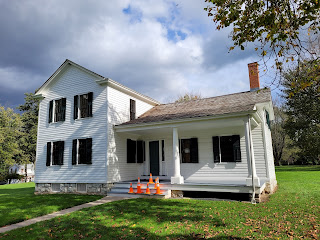Seneca Falls NY
 |
| Seneca Knitting Mill Building: Women's Hall of Fame |
With pickleball and various writing and quilting projects, our schedule has been a bit hectic the last month. We decided it would be good to take a short break somewhere we had never been. It is not completely accurate to say we had never been to Seneca Falls. We had been through it a hand full of times and Bill had worked with St. Patrick's Parish during his time at the Diocese of Rochester. However, neither of us had ever taken the time to visit and learn the history of Seneca Falls. Hence it seemed a perfect place to spend two overnights. This decision was confirmed when we found a wonderful Bed & Breakfast, Barristers.
Barristers Bed & Breakfast
The house began life in 1860 and was a residence for several generations of only two families until 2001 when it was converted into a bed and breakfast inn. Ken and Diane, our innkeepers, purchased the house in 2007 and have been providing outstanding hospitality and gourmet breakfasts ever since. The house is typically full so we were lucky to gete a reservation on usch short notice. Breakfasts were not only delicious but the company of the other guests was engaging and entertaining. They came from California, New Hampshire and Pennsylvania. We heartily recommend Barristers.
Elizabeth Cady Stanton House
 |
| Through the years, the house has been expanded, with later reductions. This is the best the National Park Service could do. The orange cones are for safety on some rickety steps. |
Click here to view all photos from Seneca Falls
First Women's Rights Convention
 |
| Wesleyan Methodist Chapel Building. Darker bricks show remains of original structure. |
When, in the course of human events, it becomes necessary for one portion of the family of man to assume among the people of the earth a position different from that which they have hitherto occupied, but one to which the laws of nature and of nature's God entitle them, a decent respect to the opinions of mankind requires that they should declare the causes that impel them to such a course.We hold these truths to be self-evident: that all men and women are created equal; that they are endowed by their Creator with certain inalienable rights; that among these are life, liberty, and the pursuit of happiness; that to secure these rights governments are instituted, deriving their powers from the consent of the governed....The history of mankind is a history of repeated injuries and usurpation on the part of man toward woman, having in direct object the establishment of an absolute tyranny over her. To prove this, let facts be submitted to a candid world.
 |
| When Susan met Elizabeth Sculptures in Seneca Falls |
The statues shown above are located on the eastern side of Van Cleef Lake which was formed by a dam on the Seneca River as part of its canalization in the early 20th Century. That elevated vantage point provides a comprehensive view of Seneca Falls. The episcopal church was particularly striking with a dark clouds covering the entire sky. As impressive as the view was, we learned the next day that this would not have been the view in 1848. Progress brought dramatic changes to Seneca Falls, some good but most turned out to be destructive.
That evening we drove 30 minutes into Auburn New York to have dinner at Elderberry Pond Restaurant. This is farm-to-table restaurant that we have wanted to visit for several years. We were able to secure a reservation. The next morning, after a truly gourmet breakfast at Barristers, we headed into town to visit the Women's Hall of Fame.
Women's Hall of Fame
Founded in 1969, "the National Women's Hall of Fame is the nation’s first and oldest nonprofit organization and museum dedicated to honoring and celebrating the achievements of distinguished American women. In August 2020, the National Women’s Hall of Fame moved into the 1844 Seneca Knitting Mill, where it uses the stories of its 293 Inductees to inspire and engage all who visit." (Website) The building that houses the Hall of Fame was in continuous use as a knitting mill from its
construction in 1844 until it closed in 1999. When it closed, the employees (overwhelmingly women) signed their names and added farewell comments on the pillars and walls of the building. Much of these have been preserved as part of the history of the building and of the women who worked there. The floors are the original floors. Since the owners of the mill were staunch abolitionists, they decided to not use cotton from the southern plantations. Rather they used wool exclusively. The natural oils and lanolin from the wool have preserved these 180 year old floors. While the original building housing the Hall of Fame used plaques for each inductee--similar to the Baseball Hall of Fame--the new building has a creative use of light and paper scrolls so that the view feels he or she is standing in the midst of these remarkable women.
We were particularly interest in the women honored in science and technology (STEM.) The story of the Matilda Effect was told several times over, unfortunately. "The Matilda effect is a bias against acknowledging the achievements of those women scientists whose work is attributed to their male colleagues. This effect was first described by suffragist and abolitionist Matilda Joslyn Gage (1826–98) in her essay, "Woman as Inventor" (first published as a tract in 1870 and in the North American Review in 1883). The term "Matilda effect" was coined in 1993 by science historian Margaret W. Rossiter. (Wikipedia) Click the link to see and hear the story of Jocelyn Bell Burnell who discovered pulsars but was excluded from a Nobel Prize awarded to two male professors.
Sauders Store
 |
| Canned peaches at Sauders Store |
Seneca Falls Heritage & Tourism Center
We stopped for lunch at Downtown Deli which felt like a step back in time and place. As its website puts it, "an original New York Deli Sandwich Shop, Downtown Deli prides itself on offering authentic New York Style, overstuffed sandwiches fast and affordable! Our store makes you feel like you're sitting in Time Square." The next time we are in Seneca Falls, we will make sure we stop in again. After lunch, we walked two minutes to the Seneca Fall Heritage and Tourism Center. This free center is open every day of the week and is staffed by volunteers. It is the best place to get any questions about Seneca Falls answered. This includes the obvious question, "Exactly where are the falls in Seneca Falls?" The answer is simple, there are no falls there and haven't been since the early Twentieth Century.
Of course, there were some falls when the first white settlers along the Seneca River arrived in the area in the late 18th century. They were part of Sullivan's March which George Washington tasked with "the total destruction and devastation of [Indian] settlements, and the capture of as many prisoners of every age and sex as possible." Four of the six tribes of the Iroquois Confederation had joined the British in the Revolutionary War and this was their punishment for choosing the wrong side. What these first white people found at the future location of Seneca Falls was a geographical feature that would determine the future of white life in the area. The Seneca River is an outflow of Lake Seneca, one of the Finger Lakes. It flows east toward Cayuga Lake (another Finger Lake) where it receives the outflow from that lake.
In its roughly 11 mile course (as the crow flies) it is essentially level with a slight slope to the east. In the roughly seven miles to the edge of Seneca Falls, it drops an insignificant 14 feet. But the two miles through Seneca Falls, it drops 50 feet. That drop created extensive rapids. As with many other locations in the Finger Lakes and Western New York, the terrain marked by drops in elevation created hundreds of rapids and water falls. And where water falls, there is energy free for the taking.
 |
| Map showing locations of waterfalls and rapids in New York State |
"By 1818 canal locks were built along the Seneca River, allowing boat traffic to avoid the rapids. By 1828, the Cayuga-Seneca Canal had been linked to the Erie Canal, making transport of raw materials and finished goods easier and opening up the much larger market for items manufactured locally." (http://www.senecafalls.com/history.php) Manufacturers and raw goods finishers of all types sprang up along the river to take advantage of the rapids and the water power they provided. Landowners along the river even leased out water rights. Seneca Falls became a major industrial center with industrial sites next to the river or on islands in the river.
There were five locks constructed to accommodate the 50 foot drop along with three man-made dams so water power would be available. The canal was southernly side of the river with the rest of the channels filled with islands and rapids. Races were constructed to harness that power to the many factories built right on the river islands. In 1915 New York State embarked on a major reconstruction of its canal system to provide for larger barges. In Seneca Falls this meant replacing the five smaller locks with two larger ones located contiguously. This required a much larger source of water. To provide this, a dam was constructed at the east end of the system which impounded what is now called Lake Van Cleef. This flooded all the low lying area of the river--called The Flats--thus eliminating the three constructed dams and the rapids along with all the factories and residences which had been build on the The Flats. Thus the answer to the perennial question--Where are the falls in Seneca Falls--is two fold. There never were any natural falls, only rapids and those constructed falls were inundated when the new locks were constructed. Ironically, none of this resulted in saving the canal business since the railroads had clearly already settled the question. The following video presents extensive information about what happened to the falls with photos and charts. It is presented by Walter Gable, Seneca County Historian.
That evening we had dinner at Kindred Fare another farm-to-table restaurant. It is located in Geneva about 30 minutes from Seneca Falls. It has a more modern vibe but the same delicious food as we had the night before.
The next morning I took advantage of the late sunrises this time of year and drove into town to capture some images of the Seneca Knitting Mill building as it was illuminated by the rising sun. The summer solstice when the sun would be at its highest point would be the time for the shot because the entire side of the building would be illuminated. This time of the sun is more southerly so that only the end is lit up. Of course, I could sleep in and get this shot as opposed to getting up a couple of hours earlier.
Women's Rights National Historical Park
 |
| Reconstructed interior where the First Women's Rights Convention took place. |
We found so much of interest in Seneca Falls that we could not get to everything. We were not able to stop by the It's a Wonderful Life Museum. This exists in Seneca Falls because of a claim that Frank Capra used Seneca Falls as a model for Bedford Falls in his 1946 movie. This is a claim that is disputed but to which the residents of Seneca Falls are committed.
We learn we didn't have to go far away to see and experience new things and people. They are all around if we only take time to look and see.






Comments
Post a Comment